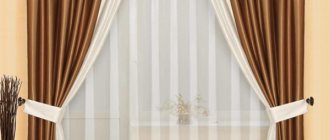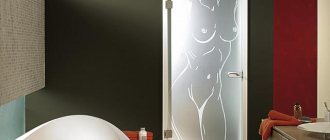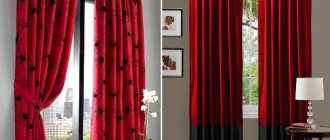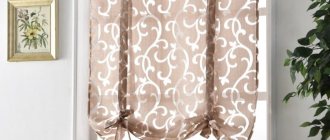How to correctly calculate the size of curtains?
Deciding on the size of curtains to fit the window is not so easy.
There are no clear parameters for sizes - you have the right to decide for yourself whether you want short curtains or floor-length curtains, whether to hang them across the entire width of the wall, or to lightly cover the window itself without any draperies. However, a few tips still need to be taken into account when choosing the size of curtains in order to avoid disappointment after purchasing curtains.
So you will first have to arm yourself with a tape measure and a calculator, and take into account the following recommendations.
How to choose the length and width of curtains for a window
The design solution for curtains depends on many factors. If the window opening occupies most of the wall, then the entire wall needs to be covered. If its size is less than two-thirds of the wall, then it makes sense to protrude beyond the window by 30 centimeters on each side, and use the rest of the area at your discretion. The cornice matters: the closer it is to the window opening, the smaller the width of the curtains. The number of layers is important. If you use only a curtain or a thin curtain, you can go 30 centimeters beyond the window. And when the structure is voluminous and multi-layered, then it is worth expanding to the entire wall.
How to calculate the width of curtains?
Correctly selected curtain width means both a beautiful window and convenient operation of the curtains.
If you skimp on the width of the material, the drapery will not look beautiful, and once you draw the curtains, you will probably have to adjust them on the other side often. The width of the fabric for curtains is chosen depending on the type of curtains and the stiffness of the fabric - thin fabrics form wrinkles more easily.
For straight canvases without draperies, roller blinds and Roman blinds, the calculation is very simple: just measure the width of the window with a tape measure, add a few centimeters and you will get the desired value.
It is more difficult to choose curtains of the appropriate width if you plan to build a complex composition with draperies. Here, curtains are selected according to the size of the room and the width of the window - the larger the room and the wider the window opening, the greater the draping of the fabric that can be allowed.
For example, if the window is more than 2 meters wide, then the curtain should be about three meters wide. And for windows 4 meters wide, curtains that exceed this value even 2-3 times will look good, especially if the fabric is thin, soft and easy to drape.
Today there are ready-made curtains on sale in a variety of sizes. Choosing the right size of curtains is the key to making your window look very impressive. And the insidious rays of the sun will not wake you up too early, breaking through the edges of the curtains onto your pillow. Let your new curtains add coziness to your home and comfort to you.
In order to choose the right new curtains, in addition to the model, type and color of fabric, it is necessary to determine the size of the required fabric.
If the calculations are made correctly, then the curtains can highlight all the advantages of the room, but if mistakes are made, this can ruin any, even the most original, stylistic decision.
That is why, before purchasing fabric or ready-made curtains, you need to carry out all the measuring work.
The place of fixation to the ceiling cornice is the point from which calculations will be made. The distance from this point to the point where the curtain ends is measured. There may be several options for execution:
- to the windowsill;
- below the windowsill;
- to the floor;
- creeping along the floor.
If the first option is used, then the distance is measured from the ceiling cornice to a point that is 1 cm above the window sill. This allows the product to move without touching.
The second option, to complete the curtain, takes a point 10–15 cm below the window sill. If the length of the product reaches the floor, its edge should rise above it by 5–6 cm, so as not to deteriorate when constantly moving along the cornice.
Finally, for the option of curtains creeping along the floor, the size is measured from the eaves to the floor and another 10–30 cm is added to the result.
How to determine the optimal width
Now the question is the required width of the canvas. First, the working width of the cornice is measured, that is, the distance along which hooks or other fasteners will move freely. The final calculation of the width depends on what filling will be chosen.
How much tulle for a window 3 meters wide
The more folds you get, the more magnificent the tulle will look. The minimum recommended filling is 1:1.5. The maximum will be 1:3. That is, a three-meter window will require 9 meters of width.
How to calculate the length from a window opening
If the curtains will hang on a curtain rod located just above the window opening, then all measurements taken should take into account the fastening system - these could be rings with clips, eyelets, drawstrings, loops, etc.
The height of the product should be calculated not from the cornice, but from the place of its attachment. Therefore, the size of the fastening elements should not be included in the length of the blade itself. Except when a drawstring or eyelet is used. Kuliska
It is a stitched pocket made of curtain fabric through which a cornice passes, usually tubular (on the cut it looks like a circle).
The length is measured from the cornice to the desired point, as discussed above. The result is added to the height of the cornice circumference and a margin of a couple of centimeters for stitching the pocket.
Eyelets
- elements that strengthen the edges of the holes in the curtain through which the cornice is threaded. When measuring the length of the fabric, you need to take into account that the grommet should be located at a distance of 2 cm from the edge of the fabric and a hem must be made on the wrong side (the length of the hem is equal to the diameter of the grommet plus 4 cm).
Important!
Artificial fabrics that are common today make it possible to reduce shrinkage during washing to a minimum. If you use fabric that consists of 60% natural fibers, then a reserve of 10% is taken for its shrinkage during washing.
What is needed for the calculation
All you need are sheets of paper, a pencil and a measuring tape (if you don't have one, you can use a measuring tape).
The size calculation is carried out in two stages: first, the height of the curtain is determined, then the amount of fabric is calculated. The same procedure is repeated to calculate the width.
Calculation stages
Stage #1:
the height of the curtain is determined. Taking into account where the bottom of the curtain will be located, its length is determined by measuring the distance from the ceiling cornice (with its fastening elements) or from the base of the wall cornice fastening elements to this bottom.
Stage #2:
the amount of fabric is calculated. The length of the hems at the bottom and top is added to the height of the curtain.
Why do you need to make calculations?
The length should correspond to the type of room in which they will be hung.
And the kitchen, living room, bedroom and children's room are completely different in their design and functionality.
And a lot will depend on the correct calculation: how the natural light source will act, how possible defects in the slopes and window sill will be hidden, how the interior of the room will be originally complemented, etc.
Tip #1.
If possible, it is better to take all measurements with a tape measure, since it is longer than a measuring tape. This way you can win exactly.
Tip #2.
Since all measurements are tied to the cornice, it must be hung in advance.
Tip #3.
The remaining fabric after cutting can be useful for creating curtain loops and ties, as well as tiebacks.
Tip #4.
If the floor is curved, height measurements should be taken in several places, for example, at the edges and in the middle. As a result, take the average value.
Attention!
There are a huge variety of fabrics that have a repeating pattern along the length. In order for the pattern to continue as a single canvas when the curtains are moved, a supply of material is needed. In this case, the height of the piece with a repeating pattern is measured, and the result obtained is added as a margin to the total length of the purchased fabric.
The length of curtains is an extremely important parameter in the decorative design of a window opening. Of course, the question of choosing a product can cause confusion for some. However, knowing the simple rules of preparatory measuring work, you can safely count on the curtains to become one of the decorations and a symbol of comfort in your home.
When finishing a renovation, people inevitably approach the stage of decorating a room with various accessories that make the room truly residential, warm and comfortable. Among the decorative elements, curtains are the main ones and require special attention. First of all, you need to find an answer to the question: how long should the curtains be to fit perfectly into the design and interior?
How to care for curtains
Over time, any curtains accumulate dust, dirt, pet hair, and unpleasant odors. Therefore, they require regular cleaning, washing and airing. If the curtains in your home are made of expensive fabrics, it is better to entrust this work to a cleaning company.
- The method for cleaning curtains depends on the fabric from which the product is made. Don't forget to read the care label on your curtains. Cotton curtains can be washed in a washing machine and do not require any special care. But for synthetic fabrics and natural silk, machine washing is prohibited. I'll have to take them to the dry cleaner. Viscose curtains are washed in cool water on a delicate cycle. After which, hang it up and allow the remaining water to drain completely. Artificial fabrics prefer hand washing only.
- It is recommended to iron curtains while damp or through damp gauze. Look at the composition of the fabric and select the appropriate iron setting. Almost all types of curtains are suitable for delicate ironing.
- Some housewives use dry cleaning, treating the curtains with a vacuum cleaner with a special soft attachment. Likewise, you can use a soft brush to remove dust and cobwebs. Don’t forget to clean the cornice while cleaning; dust, cobwebs, and dirty deposits also accumulate on it.
Curtain length: special moments
In order for the window opening to look aesthetically pleasing, and for the overall impression of being in the room to be extremely positive, it is necessary to remember that curtains have a certain length, which depends on the purpose of the room and the style chosen as the main one.
It is also important that curtains largely determine such indicators of comfort as:
- indoor microclimate;
- amount of sunlight;
- privacy.
Tastefully chosen curtains can tell more about a person than he thinks, since harmony in the home is a sign of good upbringing, having your own style and outlook on life. The length of the curtains and their style are also inextricably linked - small summer curtains for the kitchen cannot be lower than the window sill, and classic curtains from the Victorian era can reach half the window. That is why it is very important to know what the length of the curtain should be even before purchasing the fabric.
We take into account all the details
The width of the tulle roll fabrics is 2.80 m. And if the height of the future curtain is suitable in size, then calculating the number of linear meters required will not be a problem. For panels with a large pattern, the number of linear meters increases by the height of the pattern repeat. Curtain fabric has different widths. If the height of the product fits within this width, you can use a similar method.
When the length of the curtains is greater than the width of the roll, several panels have to be sewn together. This is a troublesome and time-consuming task for a non-professional.
Length: positive and negative sides
It's no secret that each length chosen for curtains will have its positive and negative aspects. Curtains that are too short will create a cozy atmosphere, but will not protect from the sun or prying eyes; flowing, long curtains are designed to become part of a private environment, but due to the fact that they often literally lie on the floor, they need frequent washing or dry cleaning. Meanwhile, correctly calculating the length of the curtain is not as difficult as it might seem.
Today it is customary to divide it into 4 main groups:
- long curtains with a floor space of up to 6 cm;
- floor-length curtains with a margin of up to 20 cm;
- curtains of medium length (up to the window sill);
- small curtains, the length of which is a quarter of the entire surface of the window opening.
The first option is considered the most common and popular today, as it is practical to use and visually looks great in most rooms. The bottom of curtains of this length practically does not get dirty, which allows cleaning the room. The disadvantage is the visual reduction in height, which does not allow choosing it in apartments with low ceilings.
It is best to choose the first and second length options if the ceiling height is not lower than 2.5 meters.
Floor-length curtains should be classics that are attractive and relevant. This length visually increases the height of the ceilings. However, if you want to sew them yourself, problems may arise. Curtains with the bottom part lying on the floor are ideal for a bedroom or living room. With the right selection of fabric, an atmosphere of comfort and luxury can be easily created. Meanwhile, there is also a minus, which is that numerous folds are prone to dust accumulation, so it may be difficult to clean the room.
Choosing curtains to the window sill allows you to indent a few centimeters up or down from the middle of the window. Such curtains are most often used for decoration in the kitchen, dining room or bathroom if it has a window opening. Such curtains are practical to use, which is a positive aspect of the choice, but they are inferior to long curtains in beauty and visual effect.
When determining the length of the curtains, it is necessary to take into account the use of accessories, for example, garters, which will slightly reduce it. If you leave long curtains just lying on the floor, they can lose their attractiveness or quickly become dirty.
Short curtains, on the contrary, have many visual advantages: they allow you to create an atmosphere of coquetry and romance. In addition, sewing them yourself will require a little fabric, and the difficulties in working will be minimal. Such curtains are less dirty, so they are ideal for the kitchen or country house. They allow air to pass through perfectly, so they can become part of the natural ventilation in the bedroom. Children will not be able to paint them, so they will also be a good option for window decoration for a child’s room. It should be taken into account that the average length can slightly reduce the visual height of the room, so they should not be made of dense, dark materials.
What are the lengths of curtains?
Today you can find curtains of different lengths. The definition of draperies according to this criterion looks like this:
- The most popular and practical option is long curtains with a distance from the bottom edge to the floor of about 6 cm. Such curtains will look especially impressive if you have high ceilings. Very convenient to use, such curtains will not get dirty when washing the floors, and the fabric will not wear out. A great classic option is floor-length curtains. They look aesthetically pleasing and quite strict, suitable for almost any furniture design. They will look great in the living room or bedroom. Visually, such curtains increase the height of the room.
- When choosing curtains for the kitchen and bathroom, pay attention to curtains that are approximately the length of the window sill. They look quite simple, but beautiful. They are easy to wash and do not take up much space. For small and frequently used rooms this is a very good option.
- If you want to create an atmosphere of luxury in the room and turn it into a chic resemblance to royal chambers, choose floor-length curtains, the lower edge of which lies in graceful folds on the floor. They will require more care than others, but they look great.
Having decided on the desired length for each room, pay attention to the cornice. It is desirable that it be at least 20-25 cm wider than the window. Ideally, its length matches the width of the room. Then the curtains will be beautifully positioned close to the edges of the wall, elegantly framing the window area.
How to correctly calculate the length: features and nuances of measurements
The length of future curtains determines the overall mood of the room, so calculations should be approached with all responsibility. In order to make all measurements correctly and purchase the necessary material in sufficient quantities so that you do not have to hastily purchase the missing amount, you need to consistently perform several simple but very important actions:
- first, the total distance from the floor to the cornice where the curtains will be fixed is measured;
- second, take into account the density of the fabric;
- third, consider the methods and types of curtain fastening.
The distance from the floor to the cornice is the basic number, to which you should add or subtract a few centimeters, taking into account other indicators. So the fastening, be it eyelets or loops, requires adding to the obtained values or reducing them by 2-10 cm. Depending on the density of the material, they also add up to 4 cm for allowances at the top and bottom of the future curtain, in general it can be up to 8 cm
If the curtains are as long as the floor, then, on the contrary, you should subtract 1 cm, if at a distance from it - minus 5-6 cm, but if directly on the floor, then you will need to add up to 20 cm. In the case of short curtains, the same manipulations are carried out, but the main reference point is not the floor or cornice, but the window sill.
Often the evenness of the floor, ceiling, window sill or window opening is far from ideal, therefore, in order not to make mistakes in the calculations and get the ideal result, you will need to take measurements at at least 5 points.
It is also important not to forget that the purchase of fabric should be made with a reserve in order to ensure that mistakes are avoided or if there is a desire to slightly change the style, you will not have to purchase additional material. Don't forget about the lining. This part of the curtain pulls the main material a little, so the margin is necessary in order to end up with a beautiful curtain.
Thus, a lot depends on the length, so you should approach its measurements carefully, take your time and take into account all the nuances and features. They can be distinguished from the style of the curtains and the desired length of the future product. It is important to remember that no matter the length, the accuracy and quality of the measuring work will guarantee that a person will receive a curtain that will become a real decoration of any room.
The length of the curtains is perhaps the first thing you need to do before starting to sew this interior element. By the way, it is the design of the room and its intended purpose that are the determining factors in choosing the size of the curtain in relation to the floor. Before choosing the type you need, it is recommended that you familiarize yourself with all possible options.
How to choose the right curtains for your living room
Curtains play the final role in the design of a living room. They give the created style completeness and harmony. Curtains are an important part of the design that should not be overlooked. After all, they are the ones who create coziness and comfort, predispose you to the chosen environment and set the mood for all residents and guests in the house. Curtains also perform a practical function, protecting the room from the sun's rays, the light of night lamps, street dust, and the curious glances of neighbors. You need to choose curtains for your living room with all responsibility. Properly selected textiles help to visually enlarge the space, hide imperfections and turn even the most ordinary surroundings into bright and interesting ones. The wrong curtains can, on the contrary, ruin everything. In this article we’ll talk about how to understand the huge number of textile options on offer and how to choose the right curtains for your living room.
Curtain length options
All curtains can be divided into two categories:
- those whose length is measured from the floor;
- and those for which it is calculated in relation to the window sill.
These two groups, in turn, can also be divided into several types. Curtains, the length of which is measured depending on its location in relation to the floor, can be divided into three categories, and those whose length is calculated depending on the level of the window sill into two. Below is a brief description of all five types and options for their placement. The question of the advantages and disadvantages of each specific type is also raised.
This style is often used to decorate either luxurious living rooms or cozy bedrooms. When selecting heavy fabrics with a strict or no pattern, an atmosphere of certain luxury and homeliness is created, in addition, dense material will hang beautifully and form folds on the floor.
The length of the canvas is calculated in such a way that there was from 10 to 20 cm of material on the floor. The illustration below shows what this option looks like in room design:
When choosing this option, certain difficulties are created when cleaning the room (since the material needs to be removed from the floor for complete wet cleaning), in addition, dust and dirt easily accumulate in the folds of the fabric located on the floor.
If you have pets in the house, additional difficulties arise. In addition to the fact that hair easily accumulates on the fabric, pets are often not averse to playing with what lies on the floor, which often causes the formation of puffs or even holes.
Curtains with a ledge 1 cm from the floor
This is a fairly common option, since it is considered classic and creates a certain rigor in the design of the room. An example of a room with this design variation is shown in the photo below:
When choosing curtains of this length, the ceiling height visually increases, which is especially valuable for rooms where they are located at a distance of less than 2.5 m from the floor.
It is easier to clean a room with such curtains than where they lie on the floor, but nevertheless, during cleaning the lower edge remains in the danger zone. Therefore, when performing wet cleaning, it is recommended to either remove such curtains or lift them and place them at a level of at least 5-6 cm from the floor.
Curtains extending 5 cm from the floor
This is the most common and simplest option, which is sometimes called a “standard curtain”. Firstly, this level of fabric hanging is the most practical, since when cleaning rooms there is no need to remove or lift the fabric. Moreover, since they are not in contact with the floor, they get dirty less and dust does not accumulate on them.
One of the most significant disadvantages of this type is that visually the ceiling height is reduced. This means that this type is acceptable for rooms where the distance from floor to ceiling is at least 2.5 m.
Curtains to the window sill
With this calculation, the material is hemmed so that the lower edge of the fabric does not reach the window sill by 1-2 cm. This type is practical, often used for kitchens or covering window openings in the bathroom.
It should be noted that this design option is rarely chosen for use in the living room or bedroom, since at this level of hanging materials the room may look unfinished, and the curtain itself may look poor. Sometimes it is acceptable to use this variety in a room where the window sill is used as an additional shelf, as well as in children's bedrooms where the windows are low.
Curtain length below window sill
This design option is often used for children's rooms, where the fabric cannot reach the floor. When calculating the material for sewing, the distance from the beginning to the end of the fabric is calculated so that the curtain hangs 10-15 cm below the window sill. This option is more practical, aesthetic and beautiful in relation to where the material does not reach the window sill.
It is also acceptable to use this type when closing a window opening in the kitchen. In the example illustrated below, there is no tulle, and the sewing material is coordinated with the color scheme of the entire kitchen.
In addition, if there are also tulles on the window in addition to curtains, then the former undertake to completely cover the latter. This means that if there is tulle on the window, then the curtain needs to be chosen longer, so the option up to the window sill will not be suitable.
To decide on the type and distance from the beginning to the end of the canvas, you need to make a general analysis of the room and take the correct measurements. The first thing you need to pay attention to is the intended purpose of this room. The curtains used in a child's bedroom will be significantly different from the kitchen curtains, and the curtain on the bathroom window will have a completely different look than in the reception room. Moreover, before purchasing or processing a material, you need to take measurements that will help in calculating the required material. To make calculations, you need to know how many centimeters from the floor to the cornice, what the height of the ceiling is (to select the type), and also analyze whether the chosen option is suitable and whether it matches the design of the room.
As can be seen from the information presented in this article, curtains, as an indispensable element of the interior, must be consistent with the design of the room, and the choice of their length largely depends on the intended purpose of the room.
Many housewives prefer to decorate the interior of their homes themselves. Numerous websites and TV shows can help with this issue today, which tell in detail how to choose the right furniture, finishing materials, and how to choose curtains for the windows. Perhaps the last element of decor raises a flurry of questions and doubts. Indeed, in addition to choosing the color, type and texture of the material, it is necessary to correctly calculate the footage of the tulle. How to do this correctly, what measurements need to be taken and what to pay attention to?
How to choose curtains for a living room
When choosing curtains for your living room, use the general rules and tips from this article.
- Considering the size of the room, decide on the shape of the curtains, color and pattern. Multi-layer, massive curtains, especially dark ones, are suitable for spacious rooms. In a small room you can hang plain light curtains; they will not eat up the space. Curtains with a horizontal contrasting print will expand the room. For rooms with low ceilings, light, light curtains are suitable.
- Decide whether the curtains should have an additional purpose or whether they are just a decorative element in the room. Curtains in the bedroom and living room can hide the room and block out sunlight and street lighting, so curtains made of thick fabric are needed here. Transparent, light curtains will fit well into the dining room and kitchen; you can consider short ones. For a child’s room, you should be especially careful when choosing; curtains in a child’s room should be fireproof, easy to clean, and not suppress the child’s psychological state. If you have very small children who are starting to walk, it will be safer to hang shorter models.
- Choose fabric for curtains. Blackout, velvet, jacquard, matting are heavy fabrics suitable for curtains. Curtains will look good in a living room or office, protecting the room from sunlight. Satin, taffeta, silk are dense reflective fabrics that enchant with their shine. For airy and graceful curtains, tulle, veil, organza, and chiffon are suitable. Gently dispersing sunlight and not blocking the panoramic view from the window, weightless fabrics are perfect for decorating a nursery, living room, or bedroom. Kisey or thread curtains will fit into the interior of any room.
- Decide on the color of the curtains. There are two options: choose curtains to match the color of the furniture or the color of the wallpaper. Let's consider the first option first. If you do not plan to change the furniture in the near future, then you can safely choose the color of the curtains for the room that is as similar as possible to the shade of the furniture. This technique is often used by designers. Universal curtains in neutral light colors look unobtrusive in any room. If the entire interior of the room is made in the same color, then the curtains should be a slightly different shade in order to take on the accent and not blend in with the furniture and walls. The second option is to select curtains to match the wallpaper. If the walls of the room are decorated with a large print, then it is better to choose plain curtains. Conversely, curtains with large or small patterns go well with plain wallpaper.
Determining the width and type of tulle
In order to calculate the required width of the tulle, you need to measure the length of the cornice. This is the basic figure from which subsequent calculations should be based.
If you plan to purchase a light curtain for the kitchen, as a rule, you opt for a translucent plain fabric. In this case, you should not drape the curtain in deep folds; a curtain laid in small waves is quite suitable. For light drapery, the width of the tulle should be calculated using the formula: cornice length * coefficient 1.5. The resulting number is the width of the future tulle curtain.
As a rule, in the living room, the window occupies almost the entire wall area. Therefore, the tulle must also be wide and long so that the entire window opening, including the walls, is hidden behind it. To create a luxurious, formal look, the curtain is draped in numerous pleats of medium depth. To calculate the width of the fabric in this case, you need to multiply the length of the cornice by a factor of 2, and to create deep drapery, take a factor of 3.
Seamstresses recommend using the following trick: to save tulle fabric, purchase a fabric 5 meters wide for a three-meter-long cornice. Most of it is distributed in the central part of the window opening, and on the sides, the window is decorated with curtains.
In order not to make a mistake with the width of the tulle curtain, you need to remember that light fabrics such as organza, voile, mesh look great in light drapery. Deeper drapery folds look impressive on curtains made of cotton and silk.











